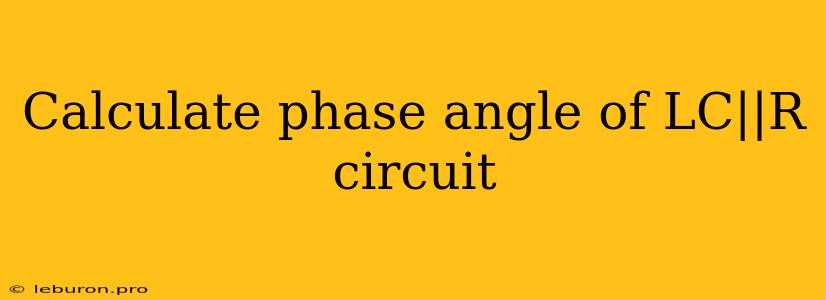Determining the phase angle of an LC parallel circuit with a resistor (LC||R) is a crucial aspect of understanding its behavior in AC circuits. The phase angle, represented by the Greek letter phi (φ), signifies the difference in phase between the voltage and current in the circuit. This difference arises due to the reactive components, inductor (L) and capacitor (C), which store and release energy, causing the current to lead or lag the voltage. Understanding the phase angle is essential for analyzing circuit performance, power calculations, and optimizing circuit design. This article delves into the method for calculating the phase angle of an LC||R circuit, exploring the underlying concepts and providing practical examples.
Understanding Phase Angle in LC||R Circuits
The phase angle in an LC||R circuit arises due to the interaction between the resistive and reactive components. The resistor (R) consumes power and contributes to the in-phase component of the current. In contrast, the inductor (L) and capacitor (C) store energy in their magnetic and electric fields, respectively. This energy storage leads to a phase difference between the current and voltage in these components.
- Inductor (L): In an inductor, the current lags behind the voltage by 90 degrees. This means that the current reaches its maximum value a quarter of a cycle later than the voltage.
- Capacitor (C): Conversely, in a capacitor, the current leads the voltage by 90 degrees. The current reaches its maximum value a quarter of a cycle earlier than the voltage.
In an LC||R circuit, the combined effect of these components determines the overall phase angle. If the inductive reactance (XL) is greater than the capacitive reactance (XC), the circuit will be inductive, and the current will lag the voltage. Conversely, if XC is greater than XL, the circuit will be capacitive, and the current will lead the voltage.
Calculating the Phase Angle
To calculate the phase angle (φ) of an LC||R circuit, we need to consider the impedance of each component. Impedance (Z) is the total opposition to current flow in an AC circuit and is expressed in ohms (Ω).
Impedance of Individual Components:
- Resistor (R): The impedance of a resistor is simply its resistance (R).
- Inductor (L): The impedance of an inductor is its inductive reactance (XL), given by XL = 2πfL, where f is the frequency in Hertz and L is the inductance in Henries.
- Capacitor (C): The impedance of a capacitor is its capacitive reactance (XC), given by XC = 1/(2πfC), where f is the frequency in Hertz and C is the capacitance in Farads.
Combined Impedance of LC||R Circuit:
The impedance of the parallel LC||R circuit can be calculated using the following formula:
1/Z = 1/R + 1/jXL + 1/jXC
where:
- Z is the total impedance of the circuit
- j is the imaginary unit (√-1)
Calculating Phase Angle (φ):
The phase angle (φ) is the angle between the total impedance (Z) and the resistance (R) in the complex impedance plane. It can be calculated using the following formula:
φ = arctan(Im(Z) / Re(Z))
where:
- Im(Z) is the imaginary part of the total impedance
- Re(Z) is the real part of the total impedance
Note: The arctan function (arctan) is also known as the tan⁻¹ function, which calculates the angle whose tangent is the given value.
Example Calculation
Let's consider an example to illustrate the calculation of the phase angle for an LC||R circuit. Assume the following values:
- Resistance (R) = 100 Ω
- Inductance (L) = 10 mH (0.01 H)
- Capacitance (C) = 1 μF (1 × 10⁻⁶ F)
- Frequency (f) = 1 kHz (1000 Hz)
Step 1: Calculate Reactances
- Inductive Reactance (XL) = 2πfL = 2π × 1000 Hz × 0.01 H = 62.83 Ω
- Capacitive Reactance (XC) = 1/(2πfC) = 1/(2π × 1000 Hz × 1 × 10⁻⁶ F) = 159.15 Ω
Step 2: Calculate Impedance
1/Z = 1/R + 1/jXL + 1/jXC
1/Z = 1/100 + 1/(j62.83) + 1/(j159.15)
Z = 62.83 Ω (approximately)
Step 3: Calculate Phase Angle
The imaginary part of the impedance (Im(Z)) is zero, as the inductive and capacitive reactances cancel each other out in this example. Therefore, the phase angle (φ) is:
φ = arctan(Im(Z) / Re(Z)) = arctan(0 / 62.83) = 0°
Conclusion
In this example, the phase angle is 0 degrees, indicating that the voltage and current are in phase. This occurs because the inductive and capacitive reactances cancel each other out at this specific frequency. However, if the frequency changes, the reactances will change, resulting in a non-zero phase angle.
Applications of Phase Angle Calculation
The calculation of the phase angle in LC||R circuits is vital for various applications, including:
- Power Factor Correction: By understanding the phase angle, we can design circuits to minimize the power factor, which is a measure of the efficiency of power utilization. This can be achieved by adding capacitors or inductors to compensate for the reactive component of the circuit.
- Filter Design: LC||R circuits form the basis of various filter designs, such as bandpass and bandstop filters. The phase angle plays a crucial role in determining the frequency response and characteristics of these filters.
- Resonance Analysis: The phase angle is crucial in understanding the resonance phenomenon in LC||R circuits. At resonance, the inductive and capacitive reactances cancel out, leading to a minimum impedance and a maximum current flow.
- Circuit Analysis and Troubleshooting: The phase angle provides valuable information for analyzing the behavior of LC||R circuits and identifying potential issues such as component failures or impedance mismatches.
Conclusion
The phase angle of an LC||R circuit is a critical parameter that reflects the interaction between resistive and reactive components. By understanding the concepts of impedance, reactance, and phase angle, we can accurately calculate the phase angle and apply this knowledge to optimize circuit performance, analyze resonance behavior, and design effective filters.
